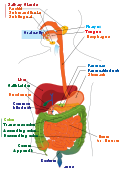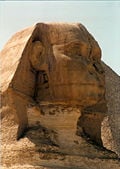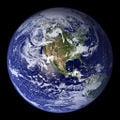 |
The United States of Americaâalso referred to as the United States, the USA, the U.S., America, or (archaically) Columbiaâis a federal republic of 50 states and the District of Columbia. |
 |
In general discussion, a nation-state is variously called a "country," a "nation," or a "state. |
 |
The gastrointestinal tract (GI tract), also called the digestive tract, alimentary canal or gut, is the system of organs within multicellular animals that takes in water and food, extracts energy and nutrients from the food, and expels the remainder as waste. |
| 120px |
The respiratory system is an integrated network of organs and tubes that coordinates the exchange of oxygen and carbon dioxide between an organism and its environment. |
 |
The Earth's atmosphere is a layer of gases surrounding our planet and retained by the Earth's gravity. |
 |
Animals are a major group of organisms, classified as the kingdom Animalia or Metazoa. |
 |
The Inca Empire (called Tawantinsuyu in modern spelling, Aymara and Quechua, or Tahuantinsuyu in old spelling Quechua), was an empire located in South America from 1438 c. |
 |
An enzyme is a biological catalyst that regulates the rate of a chemical reaction in a living organism. |
 |
Shark is the common name for any member of several orders of cartilaginous fish comprising the taxonomic group Selachimorpha (generally a superorder) of the subclass Elasmobranchii of the class Chondrichthyes. |
| 120px |
The Indus Valley Civilization (IVC), was an ancient civilization thriving along the lower Indus River and the Ghaggar River-Hakra River in what is now Pakistan and western India from the twenty-eighth century BCE to the eighteenth century BCE. Another name for this civilization is the Harappan Civilization of the Indus Valley, in reference to its first excavated city of Harappa. |
 |
Bear is the common name for any of the mammals comprising the family Ursidae of the Carnivora order, characterized by a large and heavy body, thick fur, relatively short but stocky legs, and short tails. |
|
 |
As commonly defined, the human body is the physical manifestation of a human being, a collection of chemical elements, mobile electrons, and electromagnetic fields present in extracellular materials and cellular components organized hierarchically into cells, tissues, organs,and organ systems. |
| 120px |
The main group elements of the periodic table are groups 1, 2 and 13 through 18. Elements in these groups are collectively known as main group or representative elements. |
| 120px |
World War II, also WWII, or the Second World War, was a global military conflict that took place between 1939 and 1945. It was the largest and deadliest war in history. |
 |
Ancient Egypt as a general historical term broadly refers to the civilization of the Lower Nile Valley (or the Great Rift Valley) between the First Cataract and the mouths of the Nile Delta, from circa 3300 B.C.E. |
 |
The inner transition elements are two series of elements known as the lanthanoids (previously called lanthanides) and actinoids (previously called actinides). They are usually shown below all the other elements in the standard view of the periodic table, but they really belong to periods 6 and 7. |
 |
Intelligent design (ID) is the view that it is possible to infer from empirical evidence that "certain features of the universe and of living things are best explained by an intelligent cause, not an undirected process such as natural selection" Intelligent design cannot be inferred from complexity alone, since complex patterns often happen by chance. |
 |
The Industrial Revolution was a transformation of human life circumstances that occurred in the late eighteenth and early nineteenth centuries (roughly 1760 to 1840) in Britain, the United States, and Western Europe due in large measure to advances in the technologies of industry. |
 |
Bacteria (singular: bacterium) are a group of microscopic, single-celled prokaryotesâthat is, organisms characterized by a lack of a nucleus or any other membrane-bound organelles. |
 |
The cell is a membrane-enclosed body that is the structural and functional unit of living organisms, being the smallest unit that can carry on all life processes, including maintenance, growth, replication, and self-repair. |
 |
Globalization, as a concept, refers both to the "shrinking" of the world and the increased consciousness of the world as a whole. |
 |
A spermatozoon or spermatozoan (pl. spermatozoa), from the ancient Greek ÏÏΔÏΌα (seed) and ζÏÎœ (alive), is more commonly known as a sperm or sperm cell. |
|